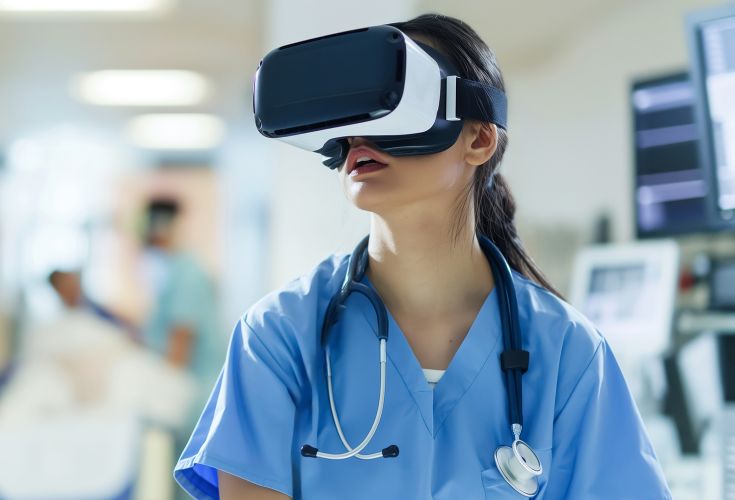Published Works
SimZone 0: The Foundation of Simulation Starts on the Screen
Executive Summary
Renowned research from the University of Kansas School of Nursing, Laura Klenke-Borgmann, PhD, RN, CHSE, published on the SimZone framework and the importance of Zone 0. She finds that Healthcare education demands scalable, competency-based solutions, yet the foundational role of screen-based simulation (SBS) within Zone 0 of the SimZones framework remains underutilized. SBS provides accessible, feedback-rich, and learner-centered experiences that strengthen cognitive and decision-making skills while aligning with accreditation frameworks such as the AACN Essentials, NONPF competencies, and INACSL Standards.
This white paper calls nursing programs and simulation centers to intentionally embed SBS as the essential starting point in a scaffolded simulation journey.


Introduction
Healthcare education faces increasing complexity, rising learner enrollment, and demands for competency-based education (CBE) (American Association of Colleges of Nursing [AACN], 2021). Despite the current healthcare education trends that focus on the benefits of CBE to address the above-mentioned challenges, pragmatic step-by-step guides for designing and assessing competency using a scaffolded simulation approach is missing (Klenke-Borgmann & Mattson, 2025).
Moreover, there remains a lack of awareness and inconsistent application of the Sim- Zones framework in United States healthcare education, particularly regarding the use and value of screen-based modalities in SimZone 0 (Roussin & Weinstock, 2017).
This gap risks underutilizing screen-based modalities in SimZone 0 that can reach large numbers of learners at scale (Foronda et al., 2020). This white paper intends to fill that gap. The purpose of this paper is to provide background and context of the SimZones framework (with an emphasis on Zone 0), explore the use of screen-based simulation (SBS) as Zone 0, and offer a call to action for nursing programs and simulation centers.
Background & Context
Roussin and Weinstock’s (2017) SimZones is a system of organization for longitudinal simulation-based learning along a developmental continuum. The framework is comprised of 5 zones with learning goals in each (Klenke-Borgmann & Mattson, 2025).
Zone 0 includes foundational, screen-based or asynchronous, self-directed learning (Fey et al., 2022; Roussin et al., 2020). Goals involve learning and practicing how to do something according to standard practice (Roussin et al., 2020). Examples include auto-feedback and virtual reality practice. Zone 0 plays a crucial role by allowing learners to build cognitive and decision-making skills before encountering higher-risk simulation environments in subsequent SimZones.
Further, Zone 1 is the context in which foundational skills are taught (e.g. deliberate practice). Learners have the chance to practice and experiment with newly learned techniques in this zone. In Zone 2, learners practice recently acquired skills in situational contexts. Zone 3 involves simulation for the ongoing development of individuals, teams, and systems. The completion of Zone 3 concludes the learning process, and moves the learner from supervised learning to independent practice. Zone 4 is not a zone of simulation. Rather, it indicates real work and patient care in the clinical environment (Roussin & Weinstock, 2017).


Screen-based Simulation as Zone 0
Screen-based simulation (SBS) tightly aligns with the objectives of Zone 0, which emphasizes foundational, asynchronous, and self-directed learning (Fey et al., 2022; Roussin et al., 2020). Defined as simulations presented on a computer screen where learners interact with virtual patients through a keyboard, mouse, or controller (Lioce et al., 2020), SBS offers features such as asynchronous access, guided inquiry, and embedded feedback (Cook et al., 2010). Screen-based simulation fosters increased knowledge/learning, initial skill acquisition, cognitive rehearsal, learner satisfaction, critical thinking, and self-regulation (Foronda et al., 2020).
These characteristics enable learners to practice according to established standards while receiving auto-feedback in a low-stakes environment, thereby fostering reasoning and judgment competencies prior to engagement in higher-risk simulation environments. Collectively, these features position SBS as an ideal vehicle for achieving the foundational goals of Zone 0.
Evidence and Application
Students value the flexibility of this on-demand modality, and research demonstrates that well-designed SBS provide authentic, clinically relevant learning experiences (Aebersold & Gonzalez, 2023).
Evidence from Shorey and Ng (2021) and Tolarba (2021) indicates that SBS effectively advances cognitive outcomes, including theoretical knowledge in medication administration, aseptic technique, managing respiratory distress, and administering blood transfusions. Building on this growing body of evidence, Sentinel U® offers practical examples of screen-based simulations that bring these benefits to life in diverse educational contexts. Across its portfolio, Sentinel U® designs immersive screen-based clinical simulations that learners can access anytime, anywhere. These scenarios include interactive encounters with virtual patients, embedded feedback, performance analytics, and debrief support through tools like EMPOWER® Debrief and METRIX® Performance Reporting, all of which creates a structured, self-paced learning experience that aligns well with Zone 0’s foundational, asynchronous learning goals.
Advantages of SBS in Zone 0
Positioning SBS within Zone 0 establishes a strong foundation for CBE in direct alignment with major accreditation frameworks, including the AACN Essentials (2021) and the NONPF Nurse Practitioner Core Competencies (2022). As a scaffolded entry point, SBS equips undergraduate learners with baseline cognitive and theoretical competencies essential for safe practice, while reinforcing advanced decision-making and clinical reasoning at the graduate level in accordance with nurse practitioner competencies and specialty preparation. Across levels, SBS delivers the flexible, scalable, and competency-mapped experiences that accreditation frameworks require, while also ensuring adherence to the INACSL Healthcare Simulation Standards of Best Practice® (2025). Additional advantages include low cost and minimal infrastructure (Cook et al., 2010), consistency and standardization (Jeffries, 2020), and suitability for prep-work, pre-briefing, and reinforcement of higher SimZones (Roussin & Weinstock, 2017).
Considerations and Recommendations
While SBS fulfills the foundational objectives of Zone 0, several important considerations must be addressed to optimize its use within healthcare curricula. First, SBS is not sufficient for developing hands-on psychomotor skills, which require direct practice with equipment, task trainers, or standardized patients in higher zones of the SimZones framework (Jeffries, 2020). Thus, while SBS is effective for knowledge acquisition, cognitive rehearsal, and decision-making, it must be complemented with experiential opportunities that allow learners to perform and refine technical skills.
Second, the successful use of SBS requires intentional curriculum integration and facilitation. To maximize learning outcomes, SBS should be mapped directly to program objectives, accreditation standards, and competency frameworks (AACN, 2021; NONPF, 2022). Faculty play a critical role in guiding learners to connect virtual experiences with clinical practice, as well as providing structured debriefing or reflection activities to promote deeper learning (INACSL Standards Committee, 2025).
Finally, SBS is most effective when used as part of an intentionally scaffolded simulation strategy that combines Zone 0 with higher SimZones. For example, SBS can serve as preparatory work for psychomotor training in Zone 1, standardized patient encounters in Zone 2, or complex team-based simulations in Zone 3. It may also be leveraged as reinforcement or remediation following immersive simulations. This integrated approach ensures that learners build a solid foundation of cognitive processing and clinical decision- making in Zone 0, while progressively advancing toward psychomotor proficiency, teamwork, and systems-based competencies (Roussin and Weinstock, 2017).
Conclusion
Screen-based simulation represents the foundation of all simulation-based education within the SimZones framework. As Zone 0, it enables learners to develop the essential competencies that prepare them for success in higher-level simulations, while also expanding access through its scalability, affordability, and flexibility. The healthcare education community is called to embrace SBS as a core, foundational strategy, ensuring that every learner—regardless of setting—can build strong, confident, and practice-ready skills from the very start of their educational journey.

References
Aebersold, M., & Gonzalez, L. (2023). Advances in technology mediated nursing education. OJIN: The Online Journal of Issues in Nursing, 28(2), Manuscript 6. https://doi.org/10.3912/OJIN.Vol28No02Man06
American Association of Colleges of Nursing [AACN]. (2021). The essentials: Core competencies for professional nursing education. https://www.aacnnursing.org/Essentials
Cook, D. A., Levinson, A. J., Garside, S., Dupras, D. M., Erwin, P. J., & Montori, V. M. (2010). Instructional design variations in internet-based learning for health professions education: A systematic review and meta-analysis. Academic Medicine, 85(5), 909-922. https://doi.org/10.1097/acm.0b013e3181d6c319
Fey, M. K., Roussin, C. J., Rudolph, J. W., Morse, K. J., Palaganas, J. C., & Szyld, D. (2022). Teaching, coaching, or debriefing with good judgment: A roadmap for implementing “with good judgment” across the SimZones. Advances in Simulation, 7(1), 39. https://doi.org/10.1186/s41077-022-00235-y
Foronda, C., Fernandez-Burgos, M., Nadeau, C., Kelley, C. N., & Henry, M. N. (2020). Virtual simulation in nursing education: A systematic review spanning 1996 to 2018. Simulation in Healthcare: The Journal of the Society for Simulation in Healthcare, 15(1), 46-54. https://doi.org/10.1097/SIH.0000000000000411
INACSL Standards Committee, Persico, L., Wilson-Keates, B., DiGregorio, H., Decker, S., & Xavier, N. (2025). Preamble: Grounded in Excellence: The Cornerstone Healthcare Simulation Standards of Best Practice®. Clinical Simulation in Nursing. https://doi.org/10.1016/j.ecns.2025.101774
Jeffries, P. R. (2020). Simulation in nursing education: From conceptualization to evaluation (3rd ed.). National League of Nursing.
Klenke-Borgmann, L., & Mattson, N. (2025). SimZones approach to a competency-based objective structured clinical examination. Nurse Educator, 50(4), 173-178. https://doi.org/10.1097/NNE.0000000000001829
Lioce, L., Lopreiato, J. O., Anderson, M., Chang, T., Diaz, D., Downing, D., Robertson, Spain, A., & the Terminology and Concepts Working Group. (Eds.). (2020). Healthcare simulation dictionary (2nd ed.). Agency for Healthcare Research and Quality. https://www.ahrq.gov/patient-safety/resources/simulation/terms.html
National Organization of Nurse Practitioner Faculties, (2022). National Organization of Nurse Practitioner Faculties’ Nurse Practitioner Role Core Competencies. https://www.nonpf.org/page/14
Roussin, C. J., & Weinstock, P. (2017). SimZones: An organizational framework for simulation programs in healthcare. Academic Medicine, 92(8), 1114-1120. https://doi.org/10.1097/acm.0000000000001746
Roussin, C. J., Sawyer, T., & Weinstock, P. (2020). Assessing competency using simulation: The SimZones approach. BMJ Simulation and Technology Enhanced Learning, 6(5), 262-267. https://doi.org/10.1136/bmjstel-2019-000480
Roussin, C. J., & Weinstock, P. (2017). SimZones: An organizational innovation for simulation programs and centers. Academic Medicine, 92(8), 1114–1120. https://doi.org/10.1097/ ACM.0000000000001746
Shorey, S., & Ng, E. D. (2021). The use of virtual reality simulation among nursing students and registered nurses: A systematic review. Nurse Education Today, 98, 104662. https://doi.org/10.1016/j.nedt.2020.104662
Tolarba, J. E. L. (2021). Virtual simulation in nursing education: A systematic review. International Journal of Nursing Education, 13(3), 48-54. https://doi.org/10.37506/ijone.v13i3.16310